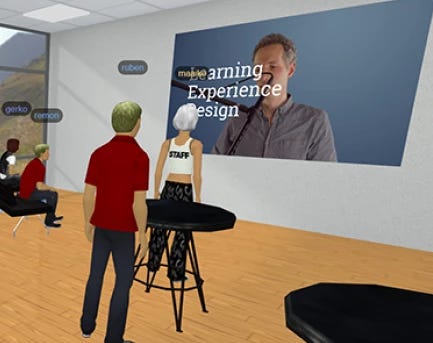Do This, Not That: Showing Lecture Videos in VR
Is it 'picture-in-picture' when it is video within VR??
In a previous Do This, Not That post I randomly chose an image to illustrate my point about the proliferation of products and companies offering digitally twinned environments. It ended up being a perfect spark for this one, because in the image those digital avatars were all standing around doing one of the most common things VR is used for in education. It also happens to be one of the least useful ways to use VR. They were watching a video on a digitally rendered wall.
I might spark some backlash with this post because this use of VR is common not just in classrooms, but also within XR practitioner communities. The goal is to make a metaverse, right? Won’t we watch videos in a metaverse?
Well, right now I don’t need to worry about a future metaverse. I will see what comes of that and modify my views if something new happens to technology or the way we interact with it. For now, I only write to what I see happening in classrooms and academic programs.
And to be perfectly frank, you will have a very hard time convincing me that putting on a VR headset to watch a video in a fake digital room is more comfortable than me being able to watch that same video without something strapped to my head.
If I can watch it on my phone while snuggled into a giant pile of pillows (and also enjoying the antics of birds at my bird feeder) that sounds far better. A VR headset just isn’t needed, or desired, in that context and I am pretty darn certain the majority of your students would agree with me.
VR introduces some negative side effects for a large portion of users, which add a barrier to their learning. Users are more prone to feeling sick within a VR setting if they do not have control over movement within that environment, such as in the case of videos playing within it. Research has found a greater occurrence of motion sickness when video was used within VR and students have pointed out that they didn’t gain anything from it being shown in that environment.
I say some version of this a lot, but I will just keep saying it until it sinks in for the people who make decisions in higher ed and for teachers making decisions in their classrooms:
XR technology must have a clearly applicable motivation for using it and include immersive content or students not only lose interest, but it becomes an unnecessary and costly technological barrier.
If the same results can be accomplished in a less uncomfortable, more easily ADA accessible medium, then that should be the first choice, not using XR.
Do This
You need to ask yourself a question:
Is there an pedagogical purpose for showing a video within a VR environment?
Or, in more simple terms: is there a reason a student can’t watch this on their phone surrounded by a giant pile of pillows?
If the answer is no, then keep your videos separate from VR. Your students will greatly appreciate it.




